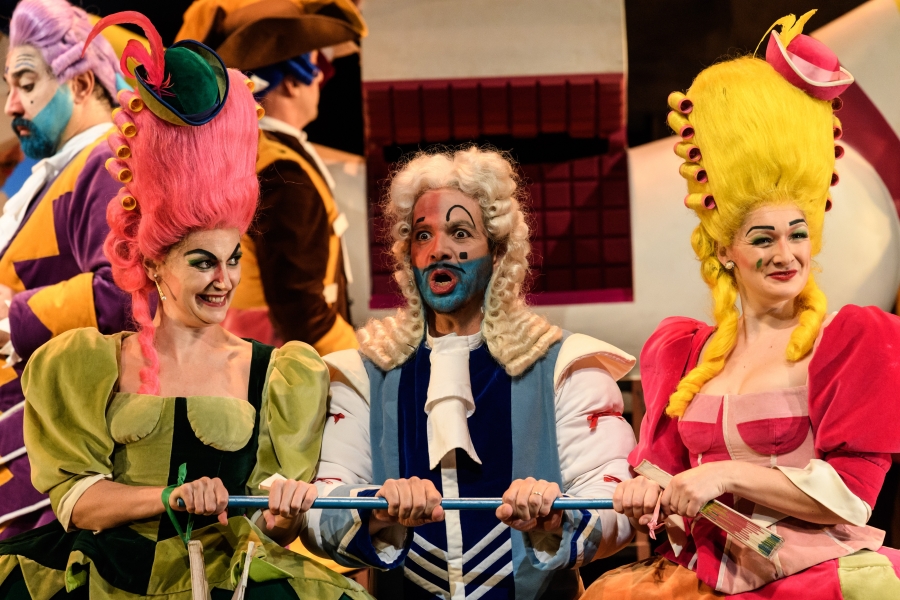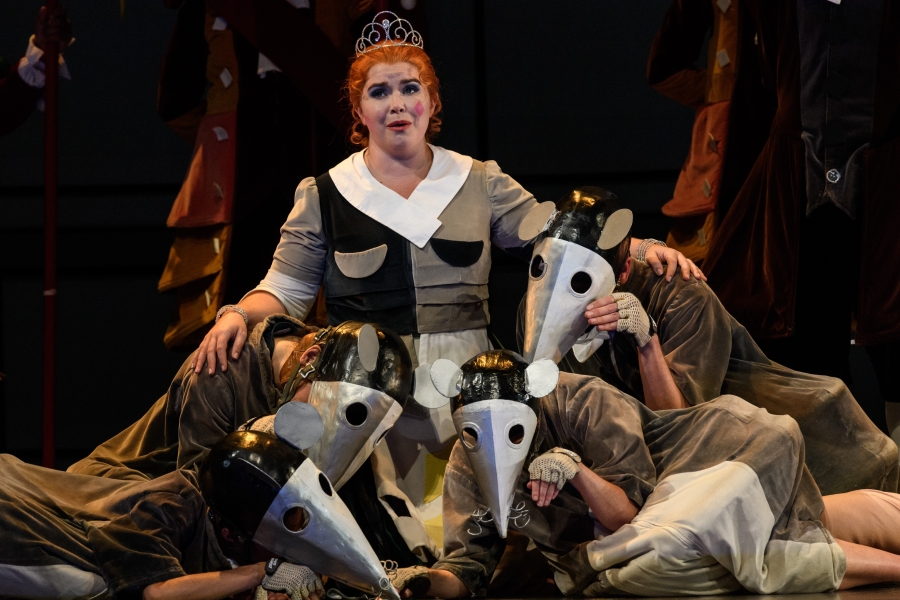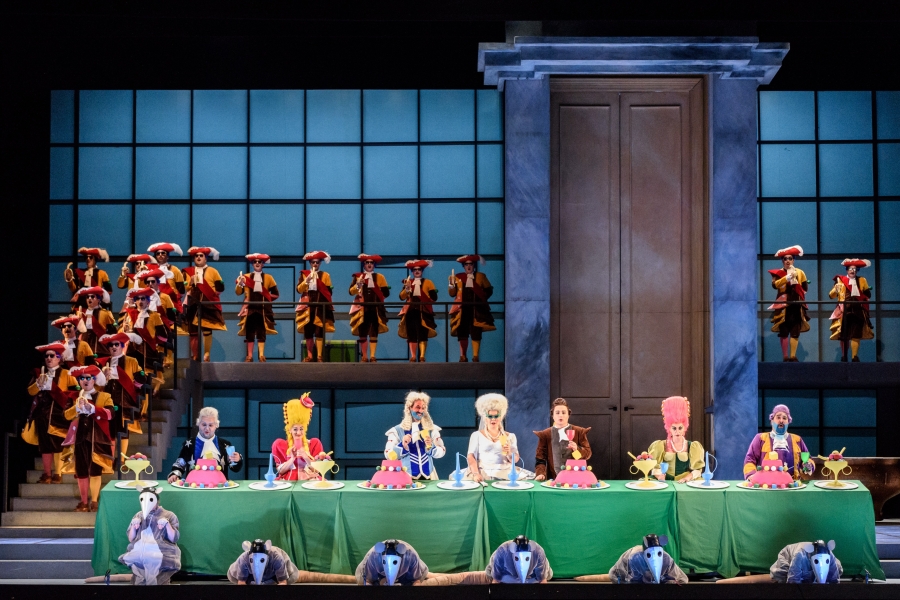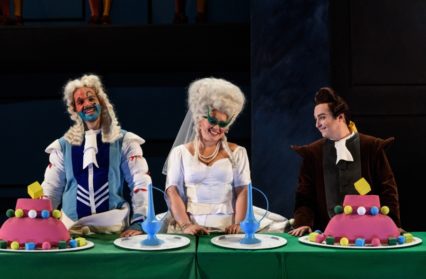Cath Barton reviews the WNO production of La Cenerentola by Charles Perrault, a variation on the classic Cinderella fairy tale.
La Cenerentola: Rossini
Welsh National Opera
Wales Millennium Centre, Cardiff, 5 October 2018
Everyone knows the story of Cinderella, the downtrodden girl who marries a prince. There have been many versions told of this myth about unjust exploitation and eventual reward. In 1697 the Frenchman Charles Perrault wrote a version which introduced into the tale a fairy godmother who turned a pumpkin into a golden coach and mice into footmen, and included a glass slipper as the device for the prince finding his love. It is this version that became the basis for the pantomime through which most of us come to the story in childhood.
Some may be disappointed that in Rossini’s opera La Cenerentola there is no fairy godmother and no pumpkin, and that the slipper is replaced by a bracelet. He had good reasons: the magic had to go because of the technical constraints of the opera house in Rome for which La Cenerentola was commissioned and where it was first performed in 1817; and censorship in the early nineteenth century prohibited the display of a bare ankle on stage. But the magic he added through his music far outweighed any loss of stage effects. The score, setting a libretto by Giacopo Ferretti which exploits to the full the extravagance of the Italian language, is a masterpiece of vocal display.

This Welsh National Opera co-production of La Cenerentola was first performed in Cardiff in 2007. Planned by its Spanish creators, Director Joan Font and Designer Joan Guillén, as a production to travel, it has since been toured around the world. Eleven years on, Joan Font, working with Revival Director and Choreographer Xevi Dorca, and the original designs, has delivered a revival which sparkles as if new-minted.
The WNO orchestra, conducted by Tomáš Hanus, WNO music director, played with all the brightness and attack that the score of this opera buffa demands, although it took a while for the pace to settle between the players and the singers dealing with the torrent of words. What was tremendous was the range of expression achieved, including the delivery of Rossini’s signature crescendos, which involve not just an increase in volume, but intricate changes in phrase length, harmony and instrumentation.

Most of the principals are new to WNO, and all impressed. Fabio Capitanucci as Cinderella’s self-seeking stepfather Don Magnifico, Matteo Macchioni as her prince charming, Don Ramiro, and Giorgio Caoduro as Ramiro’s attendant Dandini, are all Italian bel canto experts, and delivered Rossini’s demanding coloratura with skill and style. As the ugly sisters Clorinda and Tisbe – their ugliness all in their words – Aoife Miskelly and Heather Lowe were a well-matched pair of schemers, duetting with a fine interplay of spite. Wojtek Gierlach (the only principal who is not a newcomer) as the tutor Alidoro, the character charged with getting Cinderella to the ball and effecting a subsequent meeting with Ramiro, invested his role with appropriate gravitas.
This was the first time on the WNO main stage for the Irish mezzo Tara Erraught, as Angelina (Cinderella), but she inhabited it, and the character, as one completely at home. She has sung in this production in America, so is not new to working with the creative team, and indeed has worked with conductor Tomáš Hanus over a number of years. But none of that should diminish the high praise which she deserves for her apparently effortless command of Rossini’s coloratura, and to the spirit and charm with which she invested the role. It was an absolute joy to watch and listen to her.
‘Helping’ Cinderella are six other characters which Rossini did not include in La Cenerentola, though I think that if he could come back and see this production he would be delighted, as was the entire audience. These are Perrault’s mice, given rat-like (but unscary) tails and altered roles: they are dancers who observe the action, sometimes mimicking the gestures of the principals, sometimes acting as stage-hands, and, in a scene of simple brilliance, delivering a storm and the breakdown of Ramiro’s coach outside Don Magnifico’s castle.

And, last, but absolutely not least, is the prince’s retinue, the band of courtiers played by the men of the WNO chorus. Their singing added weight to the whole; their co-ordinated movements added a layer of definition. The attention given by the director and choreographer to specificity of movement by not only the chorus but all the principals made for a sharpness which contrasted with and in a sense contained Rossini’s florid music. It would be easy for a production of La Cenerentola to be too fussy or busy, but making everything a character does on stage deliberate and clear counteracts this risk. Director Joan Font puts it this way in his programme notes:
“Opera should be musical in all its forms; not just in the notes and the words, but in the steps the characters take, the postures they strike and the gestures they make.”
I felt this was achieved superbly. The design helped – a bare set with a staircase, a gantry and a large fireplace which transformed to wonderfully high doors. When the doors opened Lighting Designer Albert Faura made the most of the potential for silhouetting characters, including the scampering mice. Joan Guillèn’s costume designs were extravagant and super-colourful. The wigs, the make-up, all splendid. I’m not sure about the significance of Dandini and Don Magnifico’s blue beards, perhaps a reference to commedia dell’arte?
This was very much an ensemble production, beautifully balanced overall, and concluding with Cinderella’s famous aria Non pìu mesta, in which she sings of her transformation. What I most admired about Tara Erraught’s performance was that she was equally convincing singing a simple folksong-like melody while sweeping by the fire and in the fully panoply of vocal gymnastics in her final aria. I felt she had great vocal integrity. And perhaps this – for me at least – embodies a view of the Cinderella story which is more acceptable today than the passive ‘downtrodden girl has dream come true’ myth: that all of us have agency, and it is how you choose to act that matters, not what is done to you, good or bad.
Header photo of Giorgio Caoduro (Dandini); Tara Erraught (Angelina); don Ramiro (Matteo Macchioni) by Jane Hobson
You might also like…
What literature influence Roald Dahl? In our latest collaboration with the Roald Dahl conference of Cardiff University, Claudia Lanza explores the relationship between one of Roald Dahl’s most mischievous works, his version of Cinderella from his collection of poetic reworkings of classic fairy tales, The Revolting Rhymes, and the various source materials, and asks what role the translator plays in the reinterpretation of the classics.
Cath Barton is an English writer who lives in Wales. Her prize-winning debut novella The Plankton Collector is published by New Welsh Review. Cath is on the 2018 Literature Wales Mentoring programme, working on a collection of short stories inspired by the work of Hieronymus Bosch. https://cathbarton.com @CathBarton1



 Enjoyed this article? Support our writers directly by buying them a coffee and clicking this link.
Enjoyed this article? Support our writers directly by buying them a coffee and clicking this link.







